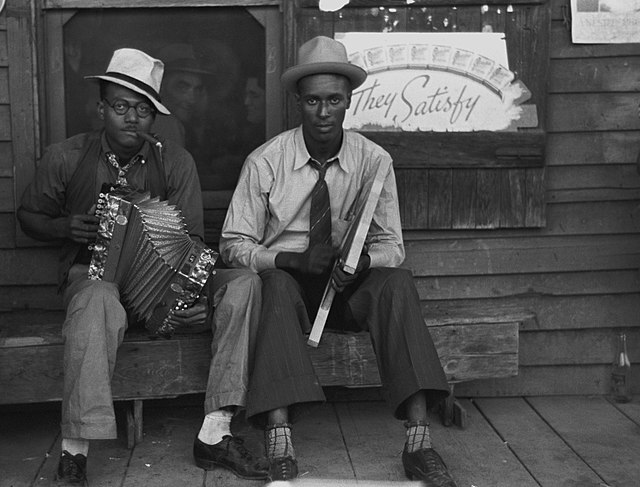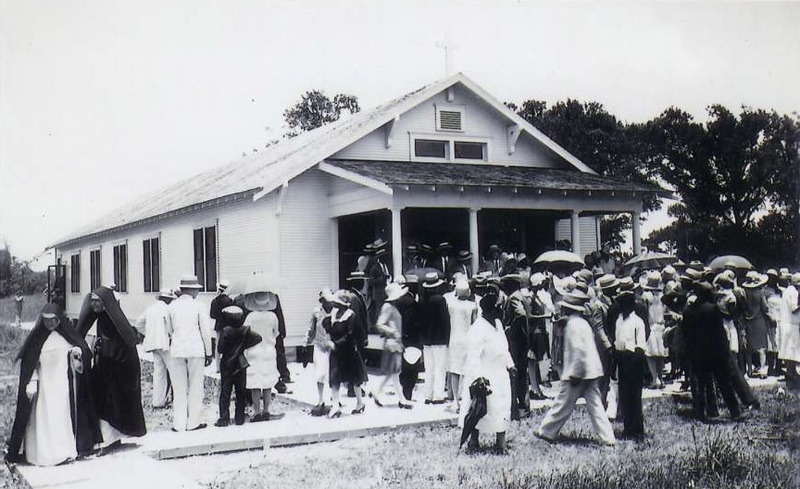Frenchtown in Harris County

Photographer: Russell Lee Date: November 1938
Immersed in the metropolitan area of Houston, the harmonies of accordions and washboards resonate throughout the Continental Zydeco Ballroom. Doris McClendon’s Continental Ballroom resided within the heart of Frenchtown. As a midpoint of cross-cultural interactions, the Continental Ballroom and other places of Frenchtown brought a new spirit to east Texas. Frenchtown was a neighborhood of great cultural and ethnic diversity. It existed as part of Fifth Ward in Harris County where many Louisianans settled in the 1920s. The neighborhood comprised of two primary groups of Louisiana descendants. One group derived from the northwestern region of Louisiana. This English-speaking population were known for their religious Protestant views. The other group that resided in Frenchtown were known as the “Creoles of Color.” The Creoles hailed from the southwestern regions of Louisiana and practiced Catholicism. In 1922, the earliest Creoles arrived in what would later be known as Frenchtown. Their native region exhibited a rich history of cross-cultural exchanges between people of African, Spanish, French, and Amerindian descent. Despite the people’s diversity and unique histories, white Texans ultimately categorized both groups as one racial group. They were referred to as black Texans and their street was considered “one of Houston’s many black neighborhoods.” The two distinct groups of Louisiana migrants disagreed with each other regarding the definition of racial blackness.
The Creoles of color and the black Texans forged their own cultural and political statuses in Frenchtown. They recognized three races: black Texans, white Texans, and the Creoles of color. To categorize these races, the inhabitants of Frenchtown distinguished people by their Louisiana history. Frenchtown Creole ancestors were not enslaved during the start of the Civil War. This leads historians, like Tyina Steptoe, author of Houston Bound: Culture and Color in a Jim Crow City, to conclude that these sociocultural groupings varied upon if their ancestors held a free or enslaved status before the Civil War. This presents a unique application of ancestral history to socially divide a community, rather than by skin color or language.
The earliest waves of Louisiana descendants came to Houston for economic aspirations. A popular employer among the resident of Frenchtown was the Southern Pacific Railroad. The Southern Pacific Railroad conscripted approximately five hundred French-speaking families, which made up about twenty three percent of Louisiana-descendent households. They were employed by the railroad establishment in 1930. The railroad intersected on Fifth Ward, making the commute easier for the residential employees. Other institutions that employed the French-speaking men was the oil industry and the Houston Ship Channel. Additionally, Frenchtown women did not omit themselves from employment. More than a quarter of women living within these communities helped support their families in the cleaning and cooking trades. Another wave of Louisianians migrated to Texas in the late 1920s after a disastrous storm. The Mississippi Flood of 1927 increased the number of Louisiana migrants looking for work in Houston. These families joined the residents of Frenchtown.
Different languages and religious beliefs greatly distinguished the two groups in the Fifth Ward. The French-speaking Creoles of color followed the Catholic beliefs and attended worship at the Our Mother of Mercy Church. The church, built in 1929, exhibited the first construction built by non-English speakers in black Houston. It also presented the first structural indicator of Frenchtown. These French-speaking migrants struggled with assimilation due to their language barrier. The struggles transformed into mockery for the Frenchtown children at their schools. Ultimately, the parents of Frenchtown prohibited their children from speaking their first language. To embrace the assimilation process in Houston, Creole families shifted their family name to a more locally recognized name. Whereas the black Texans who migrated from northwestern Louisiana kept to their English-speaking Protestant customs. Regardless, all Louisiana descendants struggled with assimilation in education.
When examining the schools of Frenchtown, there existed many cultural and linguistic interactions. Steptoe states that “Children from both groups attended the same schools, and their parents made contact at work. Differences in skin color and language could cause friction between the groups.” For instance, Artie Villas¬eñor, a Mexican American student during the Jim Crow era in Houston, explained the separation between white Americans and Mexican Americans. He stated that conflicts existed between the two groups. Following the Supreme Court’s decision to end segregation in schools, Villas¬eñor recalled how the tension between the Anglo and Mexican American students subsided as the young African American students entered his junior high school. These black Texans of course included the Creoles of color. However, Villas¬eñor’s skepticism of his new classmates was short-lived. The students shared a common interest in music. Villas¬eñor joined many African American bands and entertained black audiences. Villas¬eñor and others like him represented a group of musicians who participated in an amalgamation of several styles of music. This blending involved the musical styles of Mexican Americans, black Texans, and the Creoles of color.
During the 1960s, Creoles of color and Mexican Americans of Houston gravitated towards soul music. This process caused these groups to reconsider their racial identity. While Creoles were considered black Texans, Mexican Americans were classified as white under the law of Texas and the United States. The civil rights movements for both African Americans and Mexican Americans subsisted in Texas. When examining the musical influence on the Creoles of color in Houston, Steptoe eloquently states that “These unique expressions of rhythm and blues and soul music illustrate how the culture and politics of the long civil rights movement affected expressions of race in a society facing the legal demise of Jim Crow.” Frenchtown exhibited its own unique zydeco style. Traditional zydeco encompassed the sounds of an accordion along with the harmonics of a washboard. Singing involved both the English and French languages. However, Frenchtown zydeco developed a more contemporary sound during the 1940s in Texas. This new zydeco brought the washboard to the lead with the accordion; it also moved from the old-style French sounds. New zydeco was live weekly at the Continental Zydeco Ballroom in Frenchtown. Merging the sounds of traditional zydeco with Houston rhythm and blues revolutionized the musical culture in east Texas.
The end of geographical segregation brought diversity across the neighborhoods of Harris County. The younger residents of single-race communities, such as Frenchtown, eventually migrated out of their childhood neighborhoods. This mass movement factored into Frenchtown’s gradual fade. Houston’s construction and expansion of highways also aided in the dwindling of the neighborhood. Nevertheless, several attempts of Frenchtown’s historical preservation have occurred. Of these preservation efforts, the continuation of the zydeco sound remains essential. However the outcome, the echoes of Frenchtown zydeco will resonate among the Creole people of Texas.
Images

Photographer: Russell Lee Date: November 1938

WHITE_PHOTOGRAPHS._THEY..._-_NARA_-_557641.jpg
Photographer: Danny Lyon
Date: April 1973

Photographer: Danny Lyon
Date: April 1973

Photographer: James Fraher
